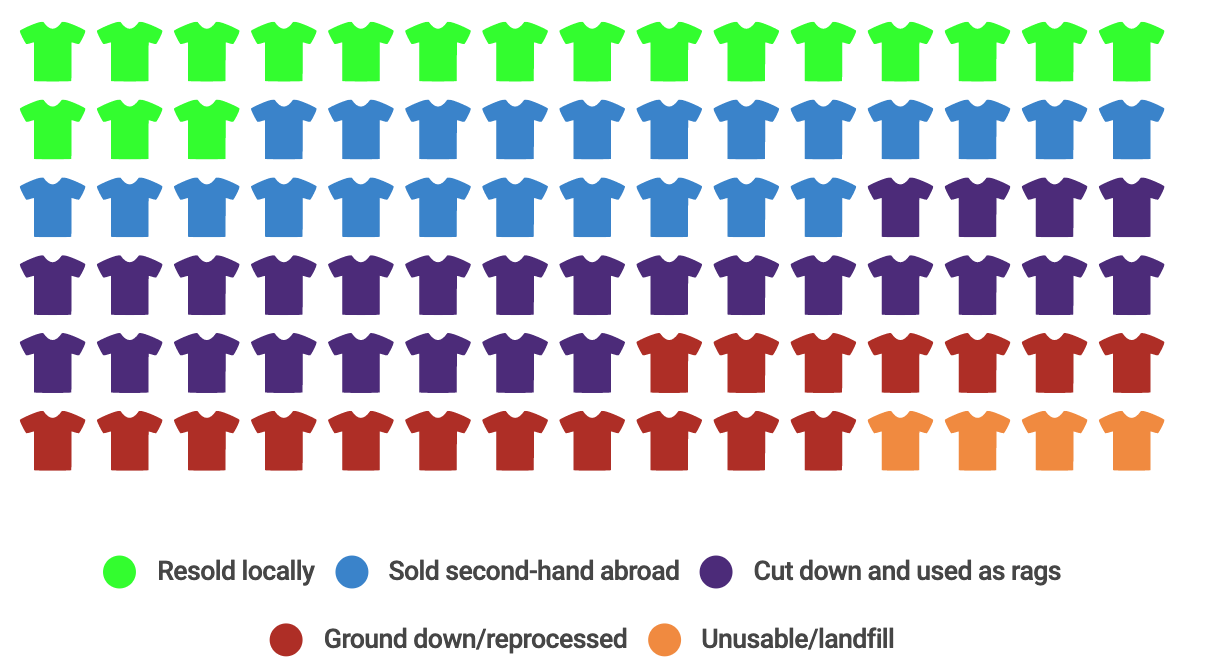Where DO my Clothes Go?
Written by: Caroleen Molenaar, Research and Content Coordinator
[7-minute read]
Cover Image: Image of Toronto Textile Recycling warehouse. Image courtesy of Christie Vuong of Macleans.
When your clothes come to the end of their life cycle or you no longer want them, we have been told that one of the most sustainable ways to dispose of them is to donate them – as opposed to throwing them in the trash. The second-hand clothing industry has boomed as a result of this, and we all feel good that we’re not polluting the environment and that our clothes will have a new life with a new owner. However, a question we often fail to ask ourselves when donating clothes is: where do our clothes actually go?
The answer is that your donated clothes go to various places as it depends on where you donate them. Canada’s most common donation options are second-hand clothing stores like Value Village, local charities like The Salvation Army, Goodwill or the Diabetes Association, a Donation Box on a street, or a take-back program hosted by stores like H&M or the Gap.
(Note: these clothing donation locations and businesses vary from country to country, and this article is written from a Canadian perspective).
Donating to a Second-hand clothing store: Value Village
When donated clothes arrive in Value Village, they are typically sorted into different categories: items that can be resold, items that become third-hand donations, and items that are thrown out to landfills. The statistics of quantities of clothing classified into each category can vary year to year report to report, or location to location, so it is hard to establish concrete evidence of where clothes actually go. Additionally, for many of the clothing items that are on display for the public to purchase, the clothes have a short shelf-life as space needs to be made for the next load of sorted donated clothing. For the items that are not sold to the public, they join the items already categorized into third-hand donations. These items typically do not stay in Canada. One avenue for these clothes is that they are shipped off in bulk to varying countries including East Africa – where Value Village has agreements with local businesses and market stalls to sell them to East African locals – Pakistan or Malaysia.[2] There are occasions where third-hand donated items are shipped to Europe or the UK if they fit the conditions of being identified as vintage or suit second-hand market demands.[3]
Figure 1: Infographic of the approximate breakdown of where your clothes go when donated. Image courtesy of CBC.
Sending clothes off to Europe or the UK does not negatively impact their culture as Canada shares many of the similar clothing trends and traits as these countries. However, exporting Canadian worn clothes to East Africa, Pakistan or Malaysia can have negative impacts on their culture as well as fashion industries. Since third-hand clothing donations often sell for less in these countries, it creates competition between imported clothing and locally made clothing as locally made clothing often costs more to purchase, therefore creates less incentive for locals to purchase it. Since 2015 six East African countries - Burundi, Kenya, Rwanda, Tanzania, and Uganda - have been attempting to ban the importation (or at least raise import taxes to decrease the amounts of imports) of second or third-hand clothing as a way to protect their own garment making industries and maintain their own cultural clothing.[4] The benefits of bans such as these would create ripple effects to countries that export clothes, such as Canada, as it could initiate more ways for these clothing export countries to become more sustainable in regards to clothing waste. As of 2021 there are no known import bans from Malaysia or Pakistan regarding exports of Canadian clothing.
Donating to a Local Charity
When donating clothes to the Salvation Army your clothing also gets sorted into varying categories: items that are sold at the Salvation Army charity shops (these also have a short shelf-life, and then are further donated to second-hand stores or are exported); items that are purchased by Value Village (that follow the same paths as described above); items that go to textile recyclers; and items that are thrown out into landfills. When clothing goes to textile recyclers they also face a variety of paths: one path is that the clothing is resold by second-hand shops run by textile recyclers; the clothing is thrown out as it might not fit the need of the textile recycler, or the clothing is shipped to be made into scraps to be used as insulation for car seats or other types of stuffing.[5]
Charities such as the Diabetes Association also accept clothing donations, but unlike the Salvation Army, they do not have an outlet to sell donations, so the donations follow a similar path laid out above except for being sold in the local charity.[6]
Donating to a Donation Box
Clothing that is taken from a Donation box faces a similar fate as described within this blog post, except – similar to the Diabetes Association-type charities – there is no direct outlet to sell them. These donated clothing items are either sold to Value Village, sold to a textile recycler, or are destined for the landfill and follow the same steps as above.[7]
Figure 3: Image of overflowing Donation Box in Ottawa, Ontario. Image courtesy of Dennis Van Staalduinen CBC.
Donating to a Take-Back Program
Clothing stores, such as H&M and the Gap have Take-Back programs where customers can donate their used clothes in the store. It is claimed by the store that they will sustainably recycle the clothes or make them into new clothes as a way to help the environment and eliminate textile waste in landfill. However, upon further research, it can be argued that these Take-Back programs are not as good as they seem for a variety of reasons. The first is that the entire production model of these fast-fashion retailers has not changed, and it is this model that is one of the driving factors into the textile waste issues that are currently within society. The second reason is that due to the components and materials of most the garments donated, it is too expensive to separate the materials from each other (ie. separating the cotton from a cotton-polyester blend is very costly). This is noted in a CBC article from 2018 that states only 0.7% of the materials of donated clothes is actually recycled which debunks the claims by these stores.[8] And thirdly, similar to donations to second-hand stores and charities, despite what the stores claim, the majority of their donations are either exported to developing countries or result in being put in landfills both of which fail to address the ongoing problem of textile waste.
Figure 4: Image of a Garment Collecting Box at H&M in Pickering Ontario. Image courtesy of Megan McPhaden.
Conclusion
In closing, donating your clothes is a complicated business. There is a lack of transparency as to where your clothes actually go because it is up to the discretion of the clothing sorters as to whether your clothes are exported, thrown out, re-bought, or repurposed. Perhaps the overarching solutions are to buy less, ensure that you are willing to wear the clothing articles for several years and support businesses that produce ethically made clothing and have a sustainable business model.
Additionally, if you or someone you know is creative with sewing, rather than donating your old clothes, ask yourself if they can be repurposed by:
Turning a pair of pants into a pair of capris or shorts or a trendy shirt,
Cutting up a shirt to make it into a dish or polish cloth,
Adding a patch to a pair of pants,
Adding embellishments to a stained or dirty shirt,
Arranging a clothing swap with others, or
Finding a local clothes swap.
Further resources:
Threading Change #Clothes Busters Campaign, click here for more info.
Dead White Man’s Clothes is a research initiative looking into the second-hand clothing industry in Ghana
Sustainably Savvy: Why Value Village is an Ethical Nightmare.
If you live in the UK we recommend you watch The Secret Life of Your Clothes which is a 1-hour documentary that follows the life of a T-shirt through its route from the UK to Ghana. (This is not legally available in Canada).
About the Author
Caroleen is a versatile researcher, writer, and editor who specializes in fashion and dress history in the areas of late 19th century fashions, Canadian fashion history, decolonization in fashion, and ethical and sustainable fashion. Having completed an undergraduate degree in Fashion and Dress History at the University of Brighton, UK, and a graduate degree in Museum Studies at the University of Leicester, UK, Caroleen is excited to find ways to share with audiences the hidden, detrimental, and positive aspects of the fashion industry and its histories. Since 2020 she also volunteers for the Association of Dress Historians, London, UK, as a Digital Communications Assistant.
References
[1] Jay, Paul. “Here’s Where Your Donated Clothes Really Ends Up.” CBC. 29 May 2018. Accessed 18 March 2021. https://www.cbc.ca/news/canada/ottawa/donated-clothing-where-it-ends-up-1.4662023.
[2] Delap, Leanne. “Where Does All Our Donated Clothing Go?” The Kit. 24 July 2019. Accessed 18 March 2021. https://thekit.ca/style/what-happens-to-donated-clothes/.
[3] Ibid.
[4] TradeMark East Africa. “A Second-Hand Clothing Ban in East Africa?” TradeMark East Africa. 2020. Accessed 21 March 2021. https://www.trademarkea.com/news/a-second-hand-clothing-ban-in-east-africa/#:~:text=Burundi%2C%20Kenya%2C%20Rwanda%2C%20Tanzania,order%20to%20increase%20domestic%20production.
Delap, “Where Does All Our Donated Clothing Go?”
[5] McPhaden, Megan. “Chapter 2: Why Dump When you Can Donate?” from Used Clothing Crisis. [n.d.] Accessed 21 March 2021. https://cusjc.ca/mrp/secondhand/chapter-1-dump-can-donate/.
[6] Ibid.
[7] Ibid.
[8] Matteis, Stephanie. “What Really Happens to Old Clothes Dropped in Those In-Store Recycling Bins?” CBC. 19 January 2018. Accessed 23 March 2021.https://www.cbc.ca/news/business/clothes-recycling-marketplace-1.4493490.






